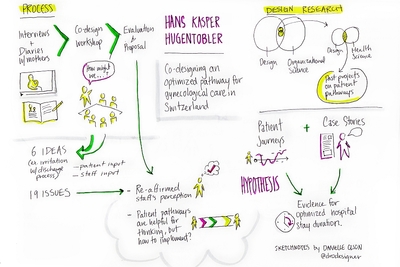Design science in health care: Co-designing an optimized patient pathway at a gynecological clinic of a large hospital in Switzerland.
Hugentobler, Hans Kaspar (2014) Design science in health care: Co-designing an optimized patient pathway at a gynecological clinic of a large hospital in Switzerland. In: Proceedings of RSD3, Third Symposium of Relating Systems Thinking to Design, 15-17 Oct 2014, Oslo, Norway.
Preview |
Text
Hugentobler_Clinic_Paper_2014.pdf Download (787kB) | Preview |
![Hugentobler_MIndMap_2014.jpg [thumbnail of Hugentobler_MIndMap_2014.jpg]](https://openresearch.ocadu.ca/2074/2.hassmallThumbnailVersion/Hugentobler_MIndMap_2014.jpg)  Preview |
Image
Hugentobler_MIndMap_2014.jpg Download (382kB) | Preview |
Abstract
Jones mentions that “Healthcare is a complex system that deals with at least two irreducible sources of complexity: The institutional (distributed provider systems and hospitals) and the personal (the biological and social setting of the human body). Furthermore these realms cannot be isolated, because the purpose of the institution is to serve individuals.” (Jones, 2013a, xviii) Hospitals operate as institutional actors under pressure to navigate changing health care contexts where patients become more knowledgeable and more demanding. The challenge for design thinking is to “transforming organizational practices by continually repositioning real human beings in the center of design and service management decisions.” (Jones, 2013a, xvii) Dubberly et. al. (2010) go even further, describing a shift where patients eventually become self-managing designers of their own well-being based on designed enabling infrastructures.
This design research project aims at demonstrating the value of the design approach vis-à-vis a care team at a gynecological clinic with regard to improving pregnant women´s experiences along the patient pathway. The scientific goal is to demonstrate how design research can yield evidence and derived design propositions to drive improvement and innovation efforts through a co-creation approach informed by an “understanding of an understanding” (Krippendorff, 2005) of women that told their stories of giving birth, generated by means of a grounded theory approach.
The research team facilitated a workshop with 8 clinic professionals (midwifes, nurses, breastfeeding counselor, department managers, clinic director), 3 patients and 1 external midwife. They crafted a model and issues-related design propositions – later to be tested in situ – of an optimized version of a patient process. The results are evaluated against the “design capability for health practice and care organizations” framework of Jones (2013b, 5) with a specific focus on design as caregiving and co-creating care (Rethinking Care), design for patient agency, patient-centered care service (Rethinking Patients), as well as innovating points of care and systemic design in healthcare innovation (Rethinking Care Systems). The results are triangulated with 2 Scandinavian, design-related projects that focus on patient pathways. The project contributes overall to an evidence creation capability of design research at the intersection of organizational and design science.
| Item Type: | Conference/Workshop Item (Paper) |
|---|---|
| Divisions: | Faculty of Design |
| Date Deposited: | 06 Nov 2017 21:01 |
| Last Modified: | 20 Dec 2021 18:18 |
| URI: | https://openresearch.ocadu.ca/id/eprint/2074 |
Actions (login required)
 |
Edit View |

 Tools
Tools Tools
Tools